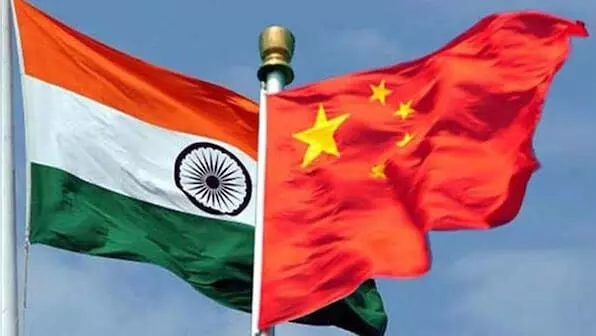Cartographic Aggression and Digital War: How China’s Map Manipulations Test India’s Sovereignty and Strategy

China's cartographic aggression
In the ceaseless geopolitical chessboard of Asia, the battle between India and China has never been confined to borders alone. It now extends deep into the digital realm — an arena where power is exercised not through armies, but through apps, algorithms, and misinformation. The recent directive by the Indian government to Google, instructing it to remove the Chinese app ‘Ablo’ for displaying an incorrect map of India, is not just an isolated act of digital policing. It reflects a long-standing history of cartographic aggression by China and the complex strategic calculations behind it.
China’s habit of distorting maps is not new. Time and again, Beijing has issued maps that deliberately omit or misrepresent territories such as Arunachal Pradesh, Jammu & Kashmir, Ladakh, and even parts of the Indian Ocean. In 1962, even before the Indo-China war, Chinese maps had begun showing Aksai Chin as part of their territory, signaling their territorial ambitions long before soldiers crossed the border.
Since then, China’s map manipulations have continued unabated — in 2013, Chinese passports issued by Beijing featured a map showing Arunachal Pradesh and Aksai Chin as part of China, drawing strong protests from India. In 2020, amid the violent Galwan clashes, Chinese state media began circulating maps excluding Ladakh from Indian territory. The cumulative effect of these repeated provocations is not merely cartographic but psychological. It serves to subtly assert China’s territorial claims, reinforce its nationalistic narrative domestically, and pressure India into a defensive posture internationally.
Why does China do this so persistently? Firstly, it’s a classic pressure tactic — using maps as diplomatic weapons to unsettle neighbors without engaging in open conflict. Maps have symbolic power. A misrepresented boundary might seem trivial on a screen, but it sends an unmistakable message about who claims what. Secondly, it’s a psychological battle. By repeatedly publishing distorted maps, China attempts to normalize its claims, desensitize the international community, and gradually undermine India’s position. Thirdly, these acts reflect China’s deeply ingrained political mentality — a mix of expansionism, information control, and strategic ambiguity. Even while seeking India’s friendship in trade, Beijing continues to assert its dominance through digital platforms, quietly waging a parallel information war.
Interestingly, this latest controversy also exposes a crucial gap in global digital governance. Is it a fault of Google that there’s no mechanism for correcting such politically sensitive inaccuracies? Technically, digital platforms operate under the laws of the countries they serve. India invoked Section 79 (3) (b) of its IT Act, which compels intermediaries to take down unlawful content on government orders. In theory, Google is obliged to act. But the reality is murkier. Global tech giants often walk a diplomatic tightrope, balancing between the regulations of multiple sovereign states and the principle of free information flow. While Google can and does remove apps or content when legally required, it rarely pre-screens content for geopolitical correctness — unless there's an existing regulatory directive. This case once again shows how tech companies, with their global reach and local vulnerabilities, have become the new battlegrounds for international disputes.
Yet, how effective is such a ban? Removing an app like Ablo from Google Play Store might curtail its visibility in India, but it won’t erase its presence entirely. Users can still access it through alternate platforms or sideloading. Moreover, misinformation, especially about sensitive issues like borders, isn’t confined to apps alone — it spreads through websites, social media posts, and AI-generated content. Even advanced AI tools today carry statutory warnings about potential inaccuracies, highlighting how technology itself is an imperfect, sometimes dangerous vessel for truth. This raises questions about whether such bans are decisive actions to defend national interest or symbolic gestures aimed at appeasing public sentiment.
There’s also a larger political context to consider. The timing of these actions often coincides with high-pitched public debates around national security, border tensions, or calls for economic nationalism. In 2020, when India banned TikTok and over 50 Chinese apps following the Galwan clash, it was widely projected as a tough, strategic blow to China’s digital footprint in India. However, the ground reality remained that India continues to heavily rely on Chinese imports for critical sectors like pharmaceuticals, electronics, and raw materials for essential medicines. While the government’s narrative positioned India as decisively severing economic ties with China, trade data revealed a different story — imports from China remained robust, and supply chains continued to be dominated by Chinese manufacturers. This duality — tough public postures, but continued economic dependencies — reflects the complexities of modern geopolitics.
So, is this ban merely another gambit by the Indian government to divert public attention or project strength when border debates flare up? It’s not entirely implausible. Governments often use digital bans to create a visible, politically palatable response without engaging in direct military or economic confrontation. It signals intent to the public, satisfies nationalist sentiment, and momentarily shifts the narrative. Yet, without addressing the deeper economic, strategic, and diplomatic asymmetries in the India-China relationship, such measures remain largely cosmetic. India might block a Chinese app today, but if it continues to rely on China for critical imports tomorrow, the imbalance persists.
Globally too, this episode fits into the larger pattern of how technology has increasingly become a double-edged sword — a source of empowerment and a conduit for disinformation. From AI-generated fake news to deepfake videos, the digital age has blurred the lines between fact and fiction. Even trusted platforms have acknowledged the risks — AI tools now routinely carry disclaimers about data accuracy, geopolitical maps on global websites come with region-specific variations, and social media giants have faced international criticism for enabling the spread of propaganda. The world’s digital infrastructure, though vast and sophisticated, remains vulnerable to manipulation, making incidents like this not just an India-China issue, but a global concern.
Ultimately, the Indian government’s directive to Google, while legally sound and politically expedient, is just one skirmish in a far larger and more complex conflict — a conflict where maps are not mere geographical tools but instruments of power, apps are not just sources of entertainment but carriers of ideology, and platforms are not neutral intermediaries but arenas of influence. Whether this is a genuine defense of national integrity or a calculated move in the theater of public perception, the implications are far-reaching. It underscores the urgent need for India to strengthen its digital sovereignty, reduce strategic dependencies, and craft a long-term, coherent policy for the digital battles of the 21st century. Because in this new age of invisible wars, the frontlines have shifted — and the fight for borders is now being waged one pixel at a time.
